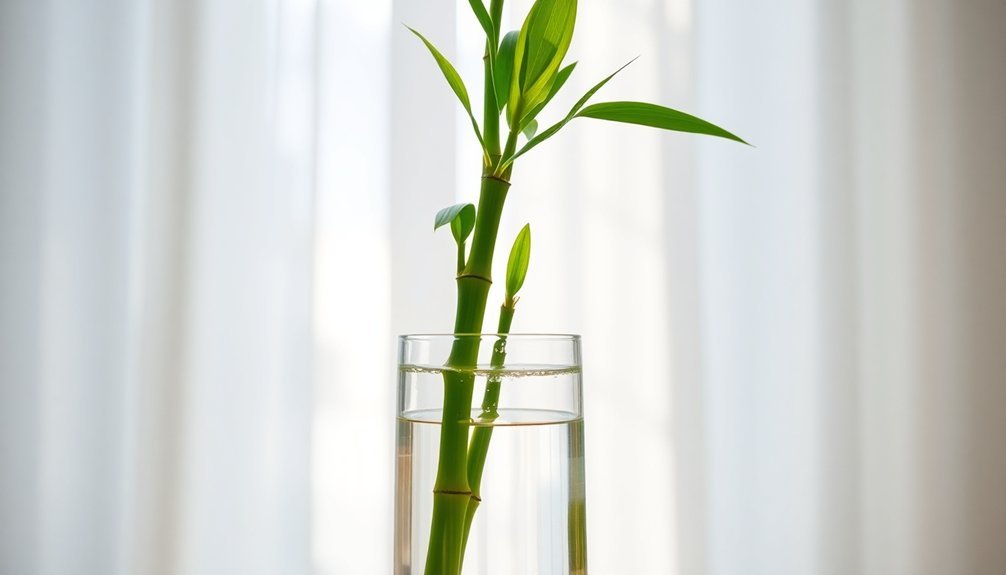If you're looking to naturally balance your home's humidity, three low-maintenance plants can help. The Peace Lily acts as a natural dehumidifier by absorbing excess moisture through its broad leaves, while Spider Plants regulate humidity through their efficient transpiration process. Lucky Bamboo thrives in humid environments and helps maintain ideal moisture levels between 40-60%. Let's explore how these green companions can transform your indoor air quality while beautifying your space.
The Peace Lily: Nature's Living Dehumidifier

While many houseplants can help regulate indoor humidity, the Peace Lily stands out as nature's most efficient living dehumidifier. With its broad leaves, it absorbs excess moisture from the air and releases it back through transpiration, creating a perfectly balanced environment in your home.
You'll find this plant particularly useful in damp spaces like bathrooms and kitchens, where it fights mold growth and maintains healthy humidity levels. The addition of its beautiful white flowers adds an elegant touch to any room while performing its humidity-balancing duties.
What makes the Peace Lily even more remarkable is its ability to thrive in these conditions while purifying your air. It removes common toxins like benzene and formaldehyde, making your living space healthier and fresher without chemical air fresheners.
To maximize its humidity-regulating benefits, simply place your Peace Lily in bright, indirect light and keep its soil consistently moist.
Spider Plants: Your Home's Moisture Management System
Just as effective as their more exotic cousins, spider plants serve as natural moisture regulators in your home through their remarkable transpiration process. These adaptable plants absorb moisture through their leaf pores while releasing water vapor, creating a balanced humidity cycle in your space.
You'll find spider plants particularly effective in rooms with poor air circulation, where they'll help maintain ideal moisture levels while removing harmful toxins like formaldehyde. Spider plants rank among the healthiest indoor options since they are non-toxic to pets.
| Feature | Benefit |
|---|---|
| Transpiration | Naturally regulates room humidity |
| Light Needs | Thrives in bright, indirect light |
| Temperature | Comfortable in 65-75°F (18-24°C) |
| Maintenance | Low-care, perfect for beginners |
| Propagation | Easy to grow new plants from spiderettes |
Keep your spider plant healthy by allowing the top inch of soil to dry between waterings and placing it away from direct sunlight.
Lucky Bamboo: Hassle-Free Humidity Control

Lucky bamboo brings tropical flair and humidity management to your home without the fussy care requirements of other indoor plants.
With ideal humidity levels between 40%-60%, you'll find this adaptable plant thrives in most indoor environments, though it prefers conditions similar to its native Central African rainforests.
You'll know your lucky bamboo needs more humidity if you spot:
- Brown leaf tips or edges
- Yellowing leaves with crispy edges
- Curled or wilted foliage
To boost humidity naturally, try placing your lucky bamboo in your bathroom or kitchen where moisture levels are higher. Misting your plant regularly with water helps create a consistent moisture level that mimics its natural habitat.
You can also create a humidity-rich microclimate by setting up a pebble tray or grouping it with other plants.
Remember to keep temperatures between 60°F-90°F and provide bright, indirect light for peak growth.
Frequently Asked Questions
Can Humidity-Absorbing Plants Trigger Allergies in Sensitive Individuals?
Yes, you can experience allergies from humidity-absorbing plants if you're sensitive to their pollen, sap, or mold that grows in damp soil. Regular maintenance and good ventilation help reduce these risks.
How Often Should I Rotate Humidity-Absorbing Plants Between Rooms?
You should rotate your humidity-absorbing plants every 1-3 months. Adjust your rotation schedule based on seasonal changes and humidity levels in different rooms, using a hygrometer to guide your decisions.
Do These Plants Work Effectively With Air Conditioning Systems?
Yes, you'll find these plants work well with air conditioning, especially thick-leaved varieties like snake plants and peace lilies. Just keep them away from direct AC vents and maintain proper humidity through misting.
What's the Ideal Number of Plants Needed for a 500-Square-Foot Room?
You'll need 5-10 medium to large plants for your 500-square-foot room. For best results, mix different species like Peace Lilies and Spider Plants, and cluster them together for maximum humidity control.
Will Humidity-Absorbing Plants Increase Indoor Mold Growth on Walls?
No, your humidity-absorbing plants won't cause mold growth on walls. They actually help prevent mold by balancing moisture levels through natural transpiration. Just make sure proper plant care and ventilation in your space.
In Summary
You'll find these three plants offer a natural and beautiful way to regulate your home's humidity. Whether you choose the elegant Peace Lily, the cascading Spider Plant, or the minimal Lucky Bamboo, you're getting more than just decoration. Place them strategically throughout your space, and you'll notice a more comfortable indoor environment. It's time to let nature help you create the perfect moisture balance at home.





Leave a Reply